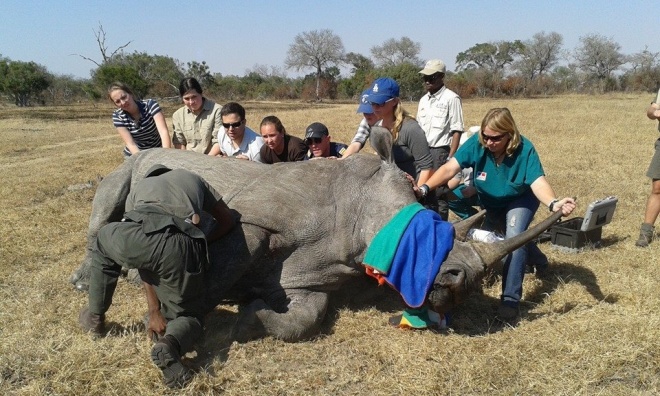Several days ago, we went to a reserve to dart and tag rhinos. I had never experienced that thrill of touching a wild rhino before, or even that adrenaline pulsing uncontrollably through my veins as I pressed down a syringe to wake a giant bull from sedation. It was a once in a life time opportunity, surely one I will never soon forget, but I did not anticipate the feeling I would get after it was all over.
We arrived at the reserve with enthusiastic smiles on our faces, ready for any action, and completely unaware of the tasks we would be needed to do. We met the vet and his team, the two helicopter pilots, and the reserve staff who would help decide which rhinos would be chosen. After introductions, we were off. The chopper soared into the air, rushing past our vehicles to seek out the rhinos from the sky. Finally we were explained the importance of the tagging procedure; it was nice to finally know what we were doing!
A tiny identification tag is drilled into the front and back horns of the rhino, and two more are placed into the body. Each darted rhino has a number, and that number is transcribed onto the rhino through various shapes cut into the ears. The significance of the tagging is not apparent until after the rhino has been poached and a horn is found in someone’s custody. If that horn has an identification number, it can be linked to a crime scene, thus prosecuting the person for having a poached rhino horn in their possession.
The first rhino was a massive bull, and I mean MASSIVE. The rhino was sedated with a drug 10,000 times stronger than morphine, which was shot by the vet from the helicopter, directly into the bull’s rump. The eyes were then covered to minimize stress on the animal, and we were all needed to help push to keep the rhino upright. Let me tell you, when a giant bull is falling on its side, it requires many hands and lots of muscle to push it back up. From the start, the breathing was regulated, and lubricant was placed on the eyes to keep them moist. Once the rhino was completely secure, DNA and blood samples were taken, patterns were cut into the ears, and holes were drilled into the horns to insert the ID tags. After all the tagging was completed, the vet raised his head and looked at me, “who wants to wake this big boy up?”. I instantly volunteered myself, and injected a milky fluid into the back of the rhino’s ear. We cleared the area quickly, and for good reason, because a few seconds later, the big bull stood up, wobbled around regaining its balance (similar to a drunk college student), and hurried off into the bush. It was a success.
This process was repeated and included a large mother with her young calf. Each darting went very smoothly, and with six interns working on the rhinos, there was a lot of hands-on experience. Whether it was drilling holes into the horn with a power tool, collecting samples, or keeping the rhino steady, it was amazing to be a part of active conservation.
What made me think twice about what we were doing that day was actually one of the highlights. Each of us got a chance to fly in the helicopter and search for the next rhino targets to be tagged. While in the air, I realized how easily visible the rhinos are from the sky; running grey masses are quickly recognized through the comparably puny trees and shrubs. When I thought more about it, we approached the rhinos exactly how poachers who flew in by helicopter would have. We darted them just as poachers would have. We worked on the rhinos while they were still alive, just as poachers would have (in many cases, the poachers hack off the horn before the rhino is actually dead). It was scary for me to see how simple it would be for the poachers to come in by air, and thus my helicopter joy ride soon turned sour. I then started to doubt the positive efforts of tagging. Sure it is essential in linking a hacked off horn to a poached victim, but that is precisely the problem. It is as if these rhinos are expected to be poached . These ID tags are useless as long as the rhino lives.
I hope all of our efforts that day are useless; that none of those beautiful rhinos will be poached. I hope those rhinos will die naturally with their identified horns still intact. But if I am realistic, I know one, if not all, of those rhinos will suffer. If that suffering leads to an essential jllegal rhino horn distributor getting caught from ID tagging, then perhaps preparing for an animal’s death could ultimately help save the species.
– Kennedy Holland
